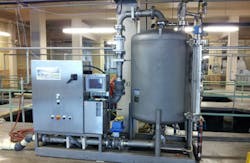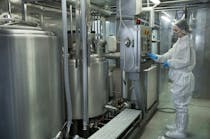Lime-softening plant cuts decarbonation chamber carbon dioxide use by 40 percent
Water-quality managers at a 120-MGD lime-softening plant in Minneapolis, Minnesota report the successful full-scale piloting of an innovative method for delivering pH-reducing carbon dioxide (CO2) to a recarbonation chamber. Plant management is seeking an alternative to less effective and more costly CO2 addition through diffusers.
The use of diffusers for CO2 addition dates to the origin of the plant in 1940, when it was built to soften water in order to minimize scaling for the utility’s industrial customers, while minimizing washing soap requirements for residential users.
"The pilot did exactly what we were hoping it was going to do," says George Kraynick, manager of water quality and laboratory services in the Minneapolis Public Works water-treatment and distribution group.
"We wanted to get more consistent pH readings in the recarbonation chamber, which we could rely on for process control, while giving us a more efficient method for re-carbonating. It did both, while also allowing us to use process water as the carrier stream for the CO2 solution, so that we did not need to use finished house water, which is in short supply here."
Kraynick said the month-long pilot operation of the proprietary system, manufactured by BlueInGreen and conducted during last March and April, showed capabilities for reducing CO2 costs by 40 percent, while ending the problem of having inconsistent pH readings, ranging from 9 to 10.5, in the piloted recarbonation chamber.
He added that the 3 ft. x 5 ft. x 9 ft. pilot skid had been readily installed by plant plumbers and electricians, and that "when they came to take the pilot away, the operators were very unhappy, because it had made their lives so much easier."
Plant operation
Raw water from the Mississippi River is pumped to a Venturi room in the lime-slaking (softening) plant, where alum is added at 15-25 mg/L for coagulation. The pretreated raw water moves to mixing chambers for addition of recycled lime sludge and lime, and then enters a main flume for addition of powder-activated carbon (PAC) before proceeding to precipitators.
After appropriate detention time in the precipitators, the stream enters two 1-million gallon recarbonation chambers for CO2 addition, as well as potassium permanganate (KMnO4) for taste and odor when needed. Recarbonated water leaving one chamber proceeds to conventional filtration, while the treated stream from the other proceeds to an ultrafiltration (UF) membrane plant.
The lime softening and recarbonation processes are utilized both for hardness control and total organic carbon (TOC) removal.
CO2 addition
CO2 is currently added through round-plate diffusers to form bubbles that are meant to be small, but sometimes reach golf ball size. Design feed rate is 1,800 lbs./hr./chamber, and averages 13-1500 lbs./hr total, 24 hours/7 days a week.
"It works, but not very efficiently," Kraynick says. "CO2 costs us $64/ton, which is inexpensive as chemicals go, but we need to optimize treatment wherever we can to reduce costs, so we needed to upgrade there."
The need for CO2 addition derives from the lime addition, which raises pH from the river at 8 to 8.5 up to 10.8-11.2 exiting the precipitators.
"At that pH level the calcium carbonate would plate out everywhere in the plant," Kraynick notes, "so we need it lower. We know the CO2 addition through diffusers is inefficient, but we also know that while we get fairly consistent pH readings of 10 +/- 0.4 at various locations in one recarbonation chamber, in the other chamber readings are very inconsistent, ranging from 9 to 10.5. And we only adjust pH at one point in our process."
To both improve efficiency and provide more consistent pH readings, Kraynick says, "We could have sought better diffusers, but instead looked to take advantage of new technology we knew was out there, and had used on our wastewater side, where CO2 gas is forced into solution, so that a super-saturated CO2 solution gets injected bubble-free."
Chose to pilot
"We chose to pilot the system from BlueInGreen in our chamber where the pH readings were too inconsistent," he continues. "The system we piloted was oversized — it could feed about 3,000 lbs./hr. — and we could have pushed all our water through the piloted chamber if we needed to."
The existing CO2 diffuser feed line was tapped to supply the gas to the pilot. Recarbonated water from the other chamber was used as feedwater for the pilot, instead of using already-burdened finished (house) water for that purpose. Tapping the house water instead would not only have limited the supply, but also required the installation of a new main, adding to the capital cost.
Initially, CO2 was injected near the diffusers, but pH readings were still too variable using that location.
According to Kraynick, BlueInGreen’s Darryl Fendley "found that injecting before water entered the recarbonation chamber solved that problem, in effect bypassing limitations deriving from its 1940 design. After that, we had stable pH readings regardless of where we took them."
Homing in on results
Readings are taken "every couple of hours," depending on slaker operation. The pilot system’s operation was connected to the plant’s SCADA system. Any pH swings caused by slaker feed issues could be addressed right away by the pilot’s control system, through auto-correction of CO2 or feedwater rates.
Control of the existing diffusers is achieved by manual adjustment of the CO2 pound per hour (pph) delivery rate, requiring plant operators to constantly monitor pH in the recarbonation basins and adjust diffuser delivery rates accordingly. "With the pilot installed, we could now know if the pH was right, on the spot, and maintain a set point," Kraynick concludes.
The CDOX CO2 dissolution and injection system was manufactured by BlueInGreen of Fayetteville, Arkansas. During the testing at the lime-softening plant, it delivered a typical CO2 dose of 15 mg/L, while treating an average flow of 30 MGD, and a range of 25-54 MGD.
The technology had already been installed at a wastewater treatment plant of a cheese and yogurt manufacturing facility in a project involving a side stream carbon dioxide (CO2) delivery system used for pH control of process water in an equalization (EQ) basin.
Mineral acids were used for pH control at this facility in the past but their use was discontinued due to safety and handling issues. Facility owners desired a more cost effective and safer solution that would also provide automatic control over process pH levels.
In the process operation, carbon dioxide gas forms carbonic acid when it is dissolved in water, in the first two of four steps that occur in carbonic acid equilibrium. The formation of bicarbonate and carbonate follow.
The system combines a side stream of water with the carbon dioxide gas in a pressurized saturation tank containing a gas head space that supplies conditions ideal for dissolving carbon dioxide.
As the water is introduced through the head space, carbon dioxide dissolves into the carrier water stream, creating a water solution that is supersaturated with carbon dioxide. Because of the high rate at which the system can dissolve carbon dioxide into water, only a small carrier side stream is needed.
Back to the plant
During the test period at the lime-softening plant, the existing diffusers were monitored to determine a baseline of performance, and they showed highly varied fluctuations in pH. Data also demonstrated the automatic response capabilities of the CDOX system to changes in recarbonation basin flow rate and influent pH.
Even when there were multiple flow-rate changes over a single day, the pH values resulting from system operation showed effective control of pH at three different basin flow rates. Separate jar testing was effective in establishing that in all cases tested, over 85 percent of pH change occurred within five minutes of CO2 injection.
With the existing diffuser system, the plant operator has to frequently check and manually adjust the diffuser output. In contrast, the pilot system maintained the pH with no input or attention required.
After the test system was decommissioned, pump disassembly showed no accumulation of scaling occurred on the impeller during the pump’s one month service with process water.
In addition, CO2 delivery rates required with the test system were compared to those required with the existing diffusers. Data used in the comparison had the same basin flow rate, influent pH, and basin pH.
The average reduction in CO2 delivery rates required with the system ranged from 21 percent to 57 percent, and showed an average of 40 percent. Consequent yearly savings were projected to be $48,800 for a target pH of 9.8, and $124,000 for a target pH of 8.5.
The CDOX technology can be applied either in-basin or in-pipe, and can be customized to minimize total cost of installation. The proprietary process, which includes a fully-integrated control scheme, is designed to provide excellent mass-transfer capabilities and near 100 percent vaporized gas utilization.
For further information, contact BlueInGreen, 700 W. Research Center Blvd., Suite 1207, Fayetteville, AR 72701, Tel. 479-527-6378, [email protected], www.blueingreen.com.


